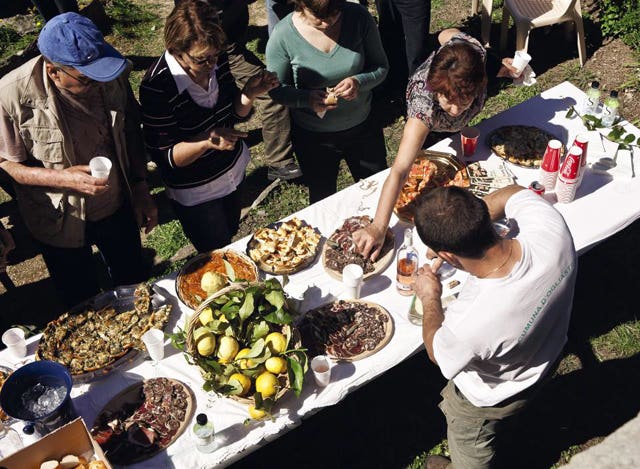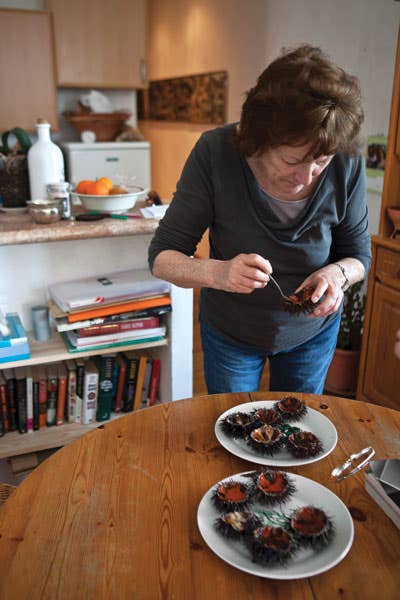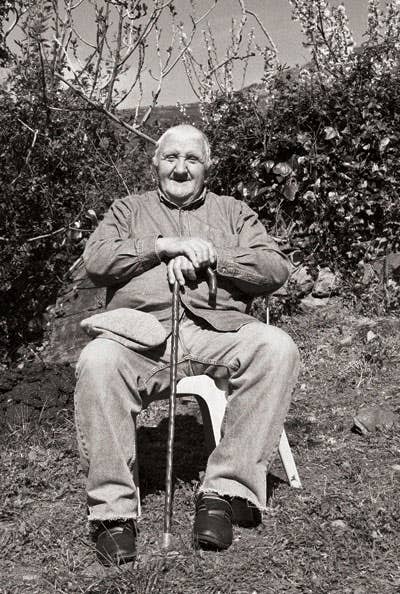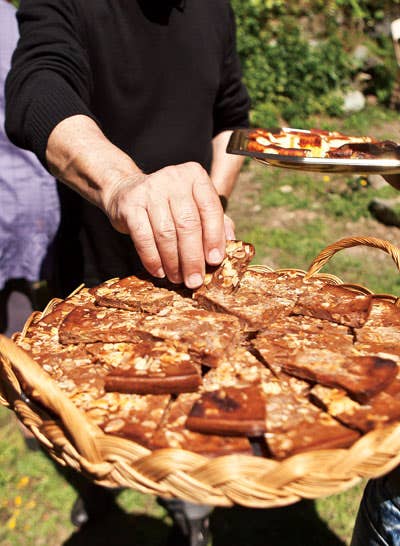
Corsica: Pleasure Island
The mountainous island of Corsica is home to a cuisine that’s equal parts Alpine, Mediterranean, French and Italian—and all its own
In the palm-shaded Corsican city of Ajaccio, I'm standing at an open window overlooking the port, which shimmers in the hot sunlight of a late-spring morning. In the distance, I can make out snow-capped mountains, which rise improbably from the Mediterranean Sea. Carried on the breeze is the incenselike scent of the maquis, the thicket of flowering shrubs and herbs that blanket nearly a fifth of this small island and creep up to the streets of Ajaccio.
I take this all in from the book-cluttered apartment of a British expat named Rolli Lucarotti. I met her only yesterday, yet we've already learned a lot about each other. I've told her that, ever since I lived in France in my 20s, Corsica—the birthplace of Napoleon, onetime fief of Genoa, now a kind of orphan province of France—has loomed large in my imagination. My fascination increased as I read accounts of the mysterious island's ancient blood feuds, its monumental prehistoric sculptures, and its sturdy cuisine. She's told me about how she and her husband moored their small sailboat in Ajaccio's harbor in 1970 during a storm and, bewitched by the beauty of the place, never left.
She's also told me about the years she spent traveling to remote mountain villages, coaxing secrets from grandmothers so she could write Recipes from Corsica (Prospect Books, 2004), the first serious English-language account of the island's cooking. It was her book that introduced me to the touchstones of Corsican food: stews made from wild game; hearty fish soups; savory tarts with local herbs; heavenly pork charcuterie; fresh farmers' cheeses and pungent, washed-rind tommes; stuffed pastas; and countless galettes and cakes made from chestnut flour, a native staple that kept many
Corsicans alive during times of siege or privation.
I watch Rolli in her kitchen, chopping a bunch of wild mint, which she scrapes into a bowl along with six farm eggs and two spoonfuls of brocciu, the moist and crumbly cheese made daily by seemingly every sheep and goat farmer on the island. "They add a little whole milk to the brocciu, so it's richer than ricotta," Rolli tells me in a Somerset accent undiminished by her years here. She pours the mixture into a skillet to make an omelet, which she cooks open face, in the unfussy Corsican style.
Before us on the table is our lunch, a meal of spare, pristine simplicity. On a platter next to the just-set omelet are a dozen sea urchins that we bought this morning at the docks. This, she tells me, is the very essence of coastal Corsican cookery, which isn't so much cookery as it is a matter of acquainting a fresh piece of seafood with a glass of wine, occasionally fire, and some wild herbs. We scoop out the iodine-sweet orange flesh with teaspoons and sip a pale, dry Corsican rose from mismatched glasses.
There is also a salad of pleasingly bitter chicory that, like much of the produce we saw this morning in Ajaccio's central market—the mint, bundles of lavender and thyme, fragrant leeks, young asparagus—were foraged in the maquis, or on other tracts of land on this still remarkably unspoiled island, where large-scale agriculture remains relatively unknown. We eat our lunch with thick slices of country bread and end it with a mousse made from tangy Corsican lemons. This is my first real Corsican meal, a taste of what's to come during the rest of my eight-day trip, and an object lesson in what a big-city chef might call "ingredient-driven cooking."

photo of Rolli Lucarotti by Beth Rooney
The next day, Rolli and I follow a hairpin road into the hills far above Ajaccio. We stop for lunch at a rustic inn called U Licettu, which Rolli has described to me as a bastion of old-school Corsican cuisine. This kind of cooking, she says, tends to reflect the culture of the mountains more than that of the coasts, parts of which were infested with malaria until World War II and remained relatively sparsely populated well into the 20th century. The meal—served in a prim dining room crisscrossed with rough-hewn ceiling beams—has no main courses, no lugubrious progression of everweightier dishes. Just small, shared pleasures: handmade cannelloni wrapped around fluffy brocciu; meaty white beans called fasgioli slow-cooked in an herb-flecked tomato sauce; light and crisp zucchini fritters brightened by wild mint; a silky terrine of wild boar, an animal that still roams freely in the maquis. And (cured-meat lover that I am) my holy grail: gossamer ribbons of dry-cured ham called prizuttu, generously marbled and dark ruby red, made from Corsican pigs fattened on the chestnuts that grow abundantly on the island. I knew that handmade charcuterie—with names, like coppa and lonzu, that hint at their Italian pedigree—is the coin of the realm here, but Rolli tells me that the extra-fatty charcuterie made from Corsican pigs is a prize on the order of Italy's finest prosciuttos.
Sated and content, I drive Rolli back to town, retracing our morning route. She spies something out the window and asks me to stop. She walks a few yards down the road and tugs green shoots from the loose dirt alongside the asphalt. "Wild garlic," she calls back to me. I shut off the engine and step out, and instantly my ears are filled with a thrumming sound. It is the noise of bees, millions of them—this, I realize, is the song of the maquis.
I'm driving over the spine of Corsica, through a stark alpine landscape so unlike the lush coast I left behind a mere 20 miles ago that it seems a continent away. I am technically in France, but not. The road signs, right down to the little tombstone-shaped mile markers, appear to be French government-issue, but the place names are in both French and Corsu, an ancient Tuscan dialect, and I notice that often the French name has been crudely redacted with black spray paint—echoes of an on-and-off independence movement that began in the 1970s. In a one-street village somewhere outside the ancient hilltop city of Corte, I stop at a little cafe-bar, park myself under the shade of an awning, and overhear men inside speaking Corsu amid the click-clack of dominoes. Their words issue forth in lusty bursts of consonants, in a distinctly Italian cadence.
A wiry older fellow wearing a gold chain gets up from the table and comes out. He presses a hand firmly onto my shoulder and almost shouts, in French, "Yes, my young man!" I order a glass of chilled red Corsican vin de pays, and a coppa sandwich. It comes with cornichons on a generously buttered baguette stuffed with thin rounds of sumptuous cured meat that could have come from the finest salumeria in Rome.
A day later, I circle back to the coast via a scrubby headland called the Agriates Desert, a scorched, jagged landscape that merges incongruously with some of the island's most idyllic beaches. I find that I'm growing accustomed to Corsica's implausible beauty and starting to dread my encroaching departure, after which I'll no longer happen upon these otherworldly sights. I decide to commemorate one of my last nights here with a special meal at Pasquale Paoli, a jewel-like restaurant in the port of L'Île Rousse, known for its modern interpretations of traditional Corsican cooking. Like many things on this island, it's named after the 18th-century statesman who was the father of Corsican independence, all 14 years of it.
I am seated under a plane tree, whose leaves form a canopy over the restaurant's little terrace, in front of a bone-white bowl that has a tiny portrait of Paoli painted on it. In the bowl, nestled in a dark, limpid broth made from spider crabs, are three delicate, hand-shaped strozzapreti. Each plump, mint-scented dumpling—made with equal parts brocciu and shredded Swiss chard—was strewn with purple borage flowers, just like ones I've seen dotting the maquis. Six bites, and the strozzapreti are gone.
Torta Pisticcina (Chestnut Flour Tart)
The star of this almond-studded tart is the flour from Corsica’s prized crop, chestnuts. See the recipe for Torta Pisticcina (Chestnut Flour Tart) »
Soon a new bowl arrives, this one bearing little rectangular sheets of toothsome pasta layered with a ragu of winey, slow-braised beef cheeks. Each bite seems to dissolve on the tongue. And before long, dessert: a sugar-dusted Paris-Brest, typically a wheel of pate a choux pastry filled with praline cream, reimagined here as a paean to that most cherished Corsican ingredient, the chestnut. The pastry is made with chestnut flour, and the cream filling is flavored with chestnuts. So is the scoop of ice cream on top, which itself is topped with a single candied chestnut. Dessert is served with a nectarlike drink called muscamaru, made from Corsican muscat and chestnut liqueur.
I sip for a while and reflect on the meal. Here were four pillars of the rustic Corsican kitchen—handmade pasta, seafood, meat stew, chestnut flour—eased gently into a new dispensation, not with any shocking wizardry, but with an eager desire to reanimate the island's bedrock foods. The chef, I found out when he stopped by my table after my meal, is named Ange Cananzi and grew up in a nearby village. "I was taught the value of our island's ingredients from a young age," he says, "and I try not to put 'luxury' ingredients on the menu." I try to imagine foie gras and caviar here, and indeed the notion seems irrelevant.
I'm due to depart tomorrow, and the spirits of this island seem to know it, for I've stumbled on a spot that no person could ever want to leave: a forested mountain glen on Cap Corse, the isle's remote, fingerlike northern tip. The glen is bisected by a burbling, sun-dappled stream called the Guado Grande and occupied by an ancient-looking stone cottage, the only work of civilization that I can see for miles around. In a grassy clearing next to the cottage, a communal picnic is getting under way—just a few folding tables covered in embroidered cotton sheets, some plastic cups for the wine. A tall man in tinted wire-rimmed glasses detaches himself from the crowd and invites me to join the potluck. His name is Jean-Toussaint. The cottage, he says, houses an old olive oil mill. The picnickers are people from the township, which has been raising money to restore the mill, and they've gathered to celebrate the first pressing of olives here in 70 years.
In the cool, stone-floored anteroom of the cottage, a half-dozen ladies set finger foods onto platters they've brought from home. Everywhere I turn, a woman offers me something to taste: little squares of homemade quiche, a slice of wild-herb-and-leek tart, farmers'-cheese beignets baked on a chestnut leaf. I migrate outside and loiter by a charcuterie platter piled with the most enticingly fatty lonzu I've ever seen, and links of figatellu, a gamy-tasting air-dried sausage made from pig livers. A stocky young guy in a soccer jersey walks up, plucks a slice of lonzu from the plate, and matter-of-factly tells me the name of the farmer who made it. "Ah," he says, tearing off a bite, "his stuff is always the best."

There are many sweets, too: dense chestnut-almond tarts, chocolate cake, and a fluffy brocciu cheesecake called fiadone. And now a napkin-lined straw basket emerges from the cottage on the arm of a pretty blond woman in a purple blouse. She walks over to me. "They're frappes," she says, raising the basket to show me the little sugar-dusted pastries inside. "Take a few!" I help myself to a handful and find a shady seat on a low stone fence where I can enjoy them. The inch-long curls of fried dough are pleasure-inducing the way cotton candy is.
And so here I am, licking sugar off my fingers and listening to the Guado Grande's waters as they descend to the Mediterranean. Sharing my patch of shade is an old man in a brimmed cap whose name is Charles Pasquini. He says he was a ship's navigator in the merchant marine. I tell him where I'm from, and he laughs. "Les Americains is the name they used to give people from Cap Corse who left for the New World and came back here to build their great mansions," he says, resting his hands on a wooden cane. I laugh, too, and think, I should be so lucky.
Keep Reading
Continue to Next Story











